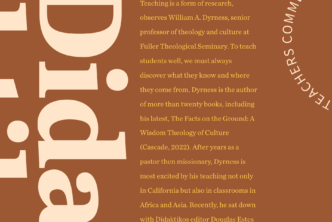The teacher might cluster atonement theories in two general camps. The first camp approaches atonement by searching for the view that best captures all the major aspects of Christ’s person, work, and ethic. In the second camp, one is keen to find that one theory implied by the collective mind within Christian history.
What are the 2 atonement theory camps?
The first camp resembles a toolbox approach. Think of it as a collage, with different pieces that can fit together in various ways. The theologian simply takes all the tools and tries to make sense of them as one whole with different parts, perspectives, or motifs. However, this approach is met with the obvious challenge that atonement doctrine occupies a central place—doctrinally akin to Christ’s nature (i.e., as both human and divine) and theology proper.
The second camp, then, attempts to meet the challenge of isolating a theory of atonement that accurately reflects the doctrinal parameters laid out by the tradition. This approach is met with the obvious challenge that there is no dogmatic statement that determines for us which atonement theory accurately embodies that which is fundamental. Some of the most fascinating developments in contemporary atonement literature reflect these approaches.1
As one of its goals, the first camp aims to articulate an atonement theory that makes coherent sense of the main contours of Christ’s person and work and an ethic that follows from them. Historically, those advocates of the moral model take it that the best atonement theory clarifies Christ’s work of modeling for us what it means to be human, thus providing an ethic to follow (often referred to as imitation theories or the moral influence theory). Following theologian Peter Abelard, advocates of moral influence contend that Christ occupies the place of shame on behalf of humanity. The apparent dogmatic problem for moral influence is the entailment of Pelagianism because, as the claim goes, Christ fails to furnish a mechanism that atones for the fundamental problem of human sin against God.2
The Christus Victor model and the restitution model avoid the problem of Pelagianism in distinct ways. Christus Victor takes it that Christ conquers the fundamental problem of human sin—death—by Christ’s power as King.3 The restitution model centers the problem in terms of God’s law, which requires a solution to human guilt.4 Both are creatively deployed in contemporary literature.
There is one restitution theory that holds primacy of place in contemporary consciousness. Rarely has a theological theory occupied such a diversity of contemporary opinion as penal substitutionary atonement, especially among neo-evangelical Calvinists. Some go so far as to suggest that it is the biblical doctrine of atonement and the reformer’s doctrine; hence, it reflects the second camp.5
Important works
Just consider a small representative sampling of some of the more important works. In The Crucified King, Jeremy Treat advances evangelical developments of penal substitution by conjoining it with Christus Victor atonement.6 This substantial development deserves a note because penal substitutionary atonement often highlights Christ’s sacrifice—hence his role as the great high priest. But as many have noted, theological developments of penal substitution sorely detract from the more important themes of Christ’s work of redemption in Scripture—namely, the fact that he is King and he has conquered sin, death, and the underworld forces. Treat constructively develops the themes of Christ’s kingship out of the essential characteristics of penal substitution. Similarly, in The Day the Revolution Began, N. T. Wright provides an account of atonement that he terms penal substitution coupled with the theme of the conquering Christ for a renewed human vocation.7 Wright highlights Christ’s assumption of Israel’s curse as the means by which he conquers death for those in the church, thus conjoining a Christus Victor theory with penal substitution. Finally, Joshua M. McNall seems to fit in the first camp. He expands penal substitution in his The Mosaic of Atonement.8 While penal substitution takes a supporting role, McNall is keen to show that it is consistent with and can accommodate ransom (i.e., the action of paying to release a prisoner from captivity), moral influence, and Christus Victor theories of the atonement.
Penal substitution has also occupied the ruminations of Christian philosophers. Eleonore Stump reflects the first camp and William Lane Craig the second. In Atonement, Stump advances a critique of penal substitution.9 She develops an objection to penal substitution’s failure to solve the most important problem of subjective union. Penal substitution satisfies only what “theologians” have called the “objective” problem. Where humans have failed to satisfy certain duties laid out by divine law, Christ satisfies those obligations in a way that God accepts for us. However, says Stump, this does nothing to solve the problem of shame and its attending consequence—the personal distance between God and humans (reflecting motivations in the moral influence theory). William Lane Craig offers a contrasting account of the atonement in his twin works The Atonement and Atonement and the Death of Christ.10 For Craig, penal substitution just is the biblical and Reformed doctrine of the atonement. Accordingly, Christ solves humanity’s most fundamental problem—namely, the debt of punishment.
Penal substitution has also met recent challenges. The most apparent challenge comes from the varied ways in which it has been defined, which beg for clarification and possibly redefinition. We are certainly familiar with feminist objections to penal substitution from divine child abuse. And, while these objections at times appear rather like ad hoc straw men, penal substitution has been met with more formidable challenges that might even demand redefinition of the concept.
First, there is the legal fiction objection, which holds that one person cannot literally assume the debt of punishment for another. This means that Christ’s sacrificial death does not actually pay for individual debts of punishment, because these individual debts are not commodities capable of being transferred in the same way that a negative balance could be paid off by a third party through a transfer of a monetary sum. Second, in response to more extreme versions of penal substitution, there is a recent set of challenges raised regarding Christological coherence. One common account of penal substitution leverages the categories of divine wrath, even hatred, to describe the debt of punishment needing satisfaction. The logic is actually quite simple. Humans are sinners by violating the divine moral law. God hates sinners. Christ becomes the substitute for sinners by stepping in the place of those sinners. Therefore, God’s hatred is directed at Christ.11 Both concerns have caused some in the recent literature to consider alternative routes.
By analyzing the mechanism of the atonement more carefully, some are recommending one of two alternatives. One possibility to reconsider the Anselmian theory of satisfaction atonement, which takes a commercial mechanism as central to the manner in which Christ eliminates the debt of punishment by paying off the debt of honor owed by humans to the divine law.12 Alternatively, some are suggesting a reworking of recent penal substitutionary developments away from divine wrath or hatred as the central debt. It is the moral law that needs satisfying rather than a personally vindictive God—hence a kind of reconceiving of penal substitutionary atonement.13
Both restitution theories of the atonement are motivated by the desire to find that one coherent theory on which all other aspects depend and which best reflects the fundamental teaching of Scripture and the collective wisdom of church history. Satisfaction accounts hold primacy of place within Roman Catholicism, but they are not out of bounds within Reformed orthodoxy, where penal substitution has greater popularity. These approaches make for an interesting convergence of ideas and provide some of the most fascinating theological discussions today because they touch on justice, law, and divine-human relations, and because the atonement is central to God’s work in the world. Students and teachers are wise to take note of contemporary atonement studies as an exercise in systematic theology that reveals the importance and varied, complex nature of this dogmatic topic.
This article was first published in print in Didaktikos: Journal of Theological Education.
- One is left to do a bit of cherry-picking of some the best literature in circulation due to space constraints.
- For a provocative account that takes shame rather than guilt as the fundamental problem and addresses the charge of Pelagianism, see Meghan Page and Allison Krile Thornton, “Have We No Shame” (forthcoming).
- The clearest and most influential defense of Christus Victor is Gregory A. Boyd, God at War: The Bible and Spiritual Conflict (Grand Rapids: IVP, 2014).
- Joshua R. Farris and S. Mark Hamilton, “The Logic of Reparative Substitution: Contemporary Restitution Models of the Atonement, Divine Justice, and Somatic Death,” ITQ 83.1 (2017): 62–77.
- William Lane Craig makes precisely these claims in his The Atonement (Cambridge: Cambridge University Press, 2018) and The Atonement and the Death of Christ (Waco: Baylor University Press, 2020).
- Jeremy R. Treat, The Crucified King: Atonement and Kingdom in Biblical and Systematic Theology (Grand Rapids: Zondervan, 2014).
- N. T. Wright, The Day the Revolution Began (San Francisco: HarperOne, 2016).
- Joshua M. McNall, The Mosaic of the Atonement: An Integrated Approach to Christ’s Work (Grand Rapids: Zondervan Academic, 2019).
- Eleonore Stump, Atonement (Oxford: Oxford University Press, 2020).
- See again William Lane Craig, The Atonement and The Atonement and the Death of Christ.
- See Joshua R. Farris and S. Mark Hamilton, “This is My Beloved Son, Whom I Hate? A Critique of the Christus Odium Variant of Penal Substitution,” Journal of Biblical and Theological Studies 3.2 (2018): 271–86; “Quenching Divine Fire: Divine Anger and the Atonement,” in Righteous Indignation, ed. Gregory L. Bock and Court D. Lewis (Lanham, MA: Lexington Books / Fortress Academic, 2021), 37–50.
- Joshua R. Farris and S. Mark Hamilton, “Reparative Substitution and the ‘Efficacy Objection’: Toward a Modified Satisfaction Theory of Atonement,” Perichoresis 15.3 (2017): 97–110. See also Joshua R. Farris and S. Mark Hamilton, Re-Envisioning Reformed Anselmian Atonement, Re-Envisioning Reformed Dogmatics (Eugene, OR: Cascade Books, forthcoming).
- See Journal of Biblical and Theological Studies 6.1 (forthcoming), which will include six articles on “The Christus Odium Variety of Penal Substitution in Contemporary Perspective.”





